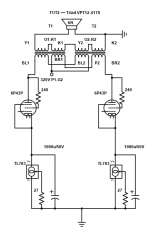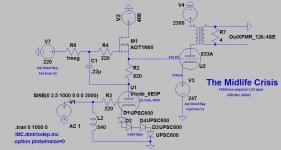The load caused by the 8X 22K resistors in parallel (2.75K) is insignificant compared to the 32R of the headphones. CC replacement won't help much.🙂
I've build a few amps that use CCS for the output. My go-to is TL783 since I run triode mode and need more than 37V but not 125V...
The aim is to be used in OTL configuration, for OT I understand that would be another matter...
What is the impedance of the load you will use?🙂
Your explanation is clear, it's easy moving the crank but a little less with maths 🙂 Why not to use, for example, 6H30 tube (Audio Research used them too...): higher plate current and higher μ. A part this, I feel that on driving low Z headphones I would go for OT instead.
Steve Bench used 6H30 in his very odd no resisters, no capacitors amplifier. It delivered 2 watts to the load.🙂
Low mu, high Gm tubes are best suited for OTL operation.
What is the impedance of the load you will use?🙂
It is about 150 Ω (medium-high Z headphones)
I've build a few amps that use CCS for the output. My go-to is TL783 since I run triode mode and need more than 37V but not 125V...
Right, TL783 may be another solution I didn't think and didn't use yet. Can you show a small draw of yours with I(L)? Thanks
bmx,
I recently tried CCS in the cathodes of my 300B. It was a NOS Motorola gold pin LM317 with the help of a powerful Mills resistor.
Good, really very good sound. Surprising to me, I admit.
I ordered the 10M90S just for the next test.
Best DIYing.
I recently tried CCS in the cathodes of my 300B. It was a NOS Motorola gold pin LM317 with the help of a powerful Mills resistor.
Good, really very good sound. Surprising to me, I admit.
I ordered the 10M90S just for the next test.
Best DIYing.
Right, TL783 may be another solution I didn't think and didn't use yet. Can you show a small draw of yours with I(L)? Thanks
I configure it as a 2 pin current source and drop it in place of the cathode resistor.
Attachments
I configure it as a 2 pin current source and drop it in place of the cathode resistor.
Simple and smart, the bypass capacitor is there for Vk stabilization?
Simple and smart, the bypass capacitor is there for Vk stabilization?
Nope. It's there to pass AC. Otherwise there would be no current change in the transformer primary, which means no magnetic field changes in the transformer, which results in no current changes in the secondary, i.e. silence.
Nope. It's there to pass AC. Otherwise there would be no current change in the transformer primary, which means no magnetic field changes in the transformer, which results in no current changes in the secondary, i.e. silence.
Ah yes, right. I've seen now it's an OT.
When CCS is being used for power tube cathode bias, please don't forget the same bypass capacitor is needed to maintain constant voltage at the cathode.
...or you could put a voltage regulator instead of a CCS under the power tube and dispense with the bypass cap. That's how the 833s in my amps are set up, with a shunt regulator maintaining the cathode voltage.
Piling on...
What would be the difference between using a voltage regulator for cathode bias and a voltage reference for cathode bias?
Aren't these both ways of creating fixed bias operation?
SY's Red Light District EL84 amp uses lots of red LEDs in the cathodes of the push-pull EL84s, for fixed bias operation.
https://www.syclotron.com/the-red-light-district-p3/
How would replacing the red LEDs with a voltage regulator be substantially different?
What would be the difference between using a voltage regulator for cathode bias and a voltage reference for cathode bias?
Aren't these both ways of creating fixed bias operation?
SY's Red Light District EL84 amp uses lots of red LEDs in the cathodes of the push-pull EL84s, for fixed bias operation.
https://www.syclotron.com/the-red-light-district-p3/
How would replacing the red LEDs with a voltage regulator be substantially different?
I'd never use voltage sources or LEDs on the cathode for biasing push-pull output stages. If I have enough B+ and not a lot of cathode current (up to 5W o the resistor) I use separate resistor/cap for self-bias. Makes my life easier matching the tubes. If I'm short of B+ or dealing with big cathode currents then I use the fixed bias with a negative supply for the grid.
For SE I always go for self-bias.
For SE I always go for self-bias.
I use the regulator to sink the 833 cathode current while maintaining the proper cathode voltage of 247V. The amp is two-stage direct-coupled with 216V on the grid of the 833. The use of a regulator fed from the B+ supply of the input stage allows me to avoid stacked power supplies.
Attachments
The amp is using adjustable fixed bias. Bias can be adjusted at either the 833 grid or cathode. Adjusting at the grid of course also affects the 6E5P input stage.If you put a voltage regulator, would that not defeat the idea of using cathode bias for current runaway protection and easy of matching? What would be the advantage of using a voltage regulator for the cathode vs fixed bias?
Understood. A DC-coupled output stage is a different beast.I use the regulator to sink the 833 cathode current while maintaining the proper cathode voltage of 247V. The amp is two-stage direct-coupled with 216V on the grid of the 833. The use of a regulator fed from the B+ supply of the input stage allows me to avoid stacked power supplies.
- Home
- Amplifiers
- Tubes / Valves
- Power tube cathode bias (CCS)

